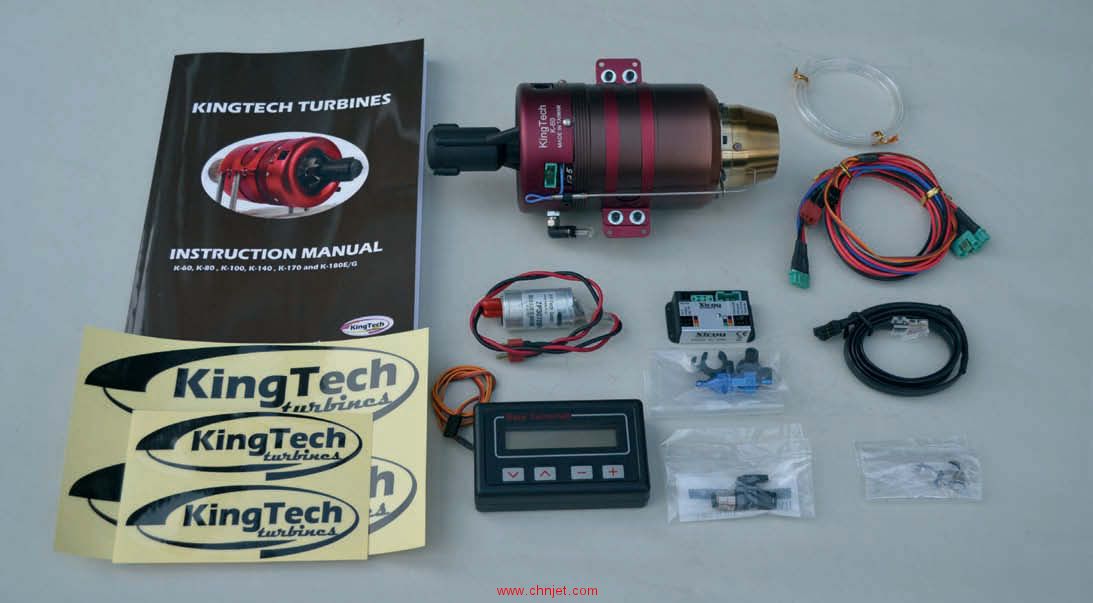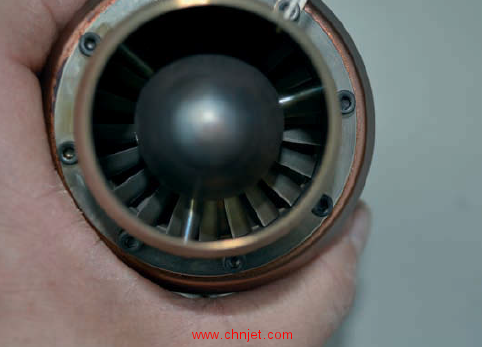|
|
马上注册,结交更多好友,享用更多功能,让你轻松玩转社区。
您需要 登录 才可以下载或查看,没有账号?立即注册

×
作者:COLIN STRAUS
图片:COLIN STRAUS
原载《Radio Control Jet International》杂志2014年06-07月刊
 Complete K-60G package containing the turbine, all ancillary parts and the detailed English language instruction manual
Complete K-60G package containing the turbine, all ancillary parts and the detailed English language instruction manual
Turbine Package Contents:
Kingtech K-60G Turbine
Fuel Pump
Xicoy ECU (Electronic Control Unit)
HDT (Hand Data Terminal)
Leads
Instruction Manual
Fuel Tubing
Manual Fuel Valve
Fuel Filter
Newbie
KingTech are a relative newcomer to the turbine manufacturing field, but have gained a strong following with their expanding range of practical, reliable and very price competitive turbines. RCJI has already tested three engines in the range, and the subject of this issue’s test is the smallest engine KingTech offer, their K-60G, which as the name suggests is nominally of 60 Newtons thrust.
There is nothing showy about the way the engine is supplied, just a sturdy cardboard box with shaped foam inner holding the turbine securely ensconced, the ancillary items being bagged and within their own smaller compartments. The long trip from the factory in Taiwan had resulted in no damage to box or components, so it was straight on to evaluating what had been supplied, commencing with the turbine itself.
The K-60G is of similar external appearance to previous KingTech engines, with a brown main casing, contrasting with the polished tailcone and red anodised intake cover and engine mounts. Quality of finish is excellent,with crisply produced components – the compressor appears to be a cast item, whilst the turbine wheel is very nicely produced.
There are a total of three connectors on the engine, two being electrical and the third the fuel input. The K-60G is a kerostart engine with the fuel and kerostart valves mounted under the front cover, thus needing only a single fuel inlet, this connector being of interest as it can be rotated to suit the installation, a very nice feature. The kerostart plug is internally mounted, so the only other item of note is the external thermocouple,which is neatly secured both front and rear.
The ECU is the well-known, compact and reliable Xicoy unit, supplied complete with its matching HDT, whilst the fuel pump is from HP-Tech GmbH of Germany. Also included is the required assortment of leads and fuel tube,fuel filter, manual fuel shut-off valve etc, as well as the very comprehensive and detailed English language manual, and some nice KingTech decals. No ECU battery is supplied,however the instructions recommend the use of a 3-cell LiFe battery or 7-cell NiMH, so for testing I used a 3-cell 9.9 volt 2100 mAh pack.
The engine comes with a ‘Limited Lifetime Warranty’ which covers the main engine components for life, with electrical and wearable components such as starter motor, fuel pump, bearings etc. having a one year warranty. If the engine is sold to a new owner within a year of original purchase then the warranty can be transferred to the new owner at no cost, after the first year the transfer of the warranty would cost $150. Like all warranties this is based on normal usage, and has exclusions for improper use, crash damage etc., etc.
 The turbine itself is very compact, and has a high quality appearance with an attractive surface finish
The turbine itself is very compact, and has a high quality appearance with an attractive surface finish
 The K-60G compressor is a nicely finished casting with excellent balance,going by the lack of balancing marks
The K-60G compressor is a nicely finished casting with excellent balance,going by the lack of balancing marks
 High quality is also evident in this photo of the turbine wheel, the finish of the blades being particularly crisp
High quality is also evident in this photo of the turbine wheel, the finish of the blades being particularly crisp |
|
![]()